Private sector rent statistics: 2010 - 2018
This publication presents statistics on private sector rent levels in Scotland over the years 2010 to 2018.
Annex C - Methodology (Source Data Collection, Sampling Methodology, Sample Sizes)
Data Source
This publication uses data from the Rent Service Scotland 'Market Evidence Database'. This database is used to meet the needs of determining annual Local Housing Allowance levels and Local Reference Rent, and is data that has previously been published in the form of 30th percentile rental prices[11].
The market evidence data on private rents is sourced through a variety of means, including:
- private landlord and letting agent returns,
- mailshot initiatives, and
- advertised rental information.
The database excludes any rents related to social housing, mid-market rents, halls of residence, and private tenancies known to be the subject of housing benefit and regulated tenancies. In the latest year, an estimated 98% of records were based on advertised rents, with the remainder being based on actual rents from landlord returns.
The data collected includes a minimum level of address, property attributes and tenancy details. Rents relating to studio/bedsit properties, properties with 5 or more bedrooms, and bed and breakfast lodgings have been excluded from this publication due to small sample sizes. Rents for bedrooms in shared properties are presented as 'rent only' figures, i.e. do not include the additional cost of shared services where these are known.
If a particular property has more than one piece of market evidence available in a given year, then only the most recent item of evidence for that year has been used in the average rent calculations for this publication.
Rent Officer Market Evidence Collection Methodology
The private rented sector is de-regulated, meaning that landlords are free to charge an open market rent for their property. There is currently no legal obligation for landlords or agents to provide Government, or any other organisations, with details of the rents achieved on their lettings. Therefore rent officers have to actively seek, collect, validate and maintain a suitable dataset.
Sample Sizes
There is no requirement for rent officers to collect 100% of rents that are agreed between landlord and tenant. Neither is it realistic to assume that all landlords and letting agents would be able to co-operate with this requirement.
Rent Officers instead aim to capture a representative sample of around 10% of private rents based on the total number of records obtained (the amount of records used in average rent calculations may be slightly less than this due to removal of any multiple records for a single property/address in a given year). Landlord registration data and census data is used as a baseline for establishing and monitoring the total sample proportion that is aimed to be achieved.
As rent officers do not have access to every letting that takes place in the market the use of a random sample is not feasible, and given the variations in the size of the markets in each Broad Rental Market Area a simple quota based sample would be unlikely to produce representative results either. The sample should ideally reflect the profile of the market in terms of the type of property, its distribution, and the letting sources within each Broad Rental Market Area. There are no definitive measures for these so rent officers monitor local market activity and take every opportunity to acquire feedback from landlords, agents and tenants. This market intelligence means that rent officers are able to continually evaluate the composition of the list of rents used for LHA, and where necessary divert resources from their regular program of data collection to address any perceived weakness in the data. This combined approach of regular and targeted collection based on market intelligence aims to produce a representative sample for each property size for each Broad Rental Market Area. This approach in turn reflects the structure of the legislation which allows for rent officer judgment on a number of these factors.
The private rented sector is very complex and is continually changing as it reacts to market forces. The overall target of a 10% sample therefore only represents a guide figure at Broad Rental Market Area level. Local knowledge, confidence testing and interpretation of other available data may be applied to refine the guide level. This contributes towards achieving a representative sample for each property size category at a Broad Rental Market Area level.
It is important to note that the data collected on individual rents may encompass different property types and addresses for each data collection year, and that this publication is not an attempt at providing a case-matched, tracked-sample or weighted-index approach to monitoring changes to rent levels over time. See Annex D for further information on methodological differences to the ONS Index of Private Rents.
The Broad Rental Market Area Profiles show the sample sizes for each rental area. It can be seen that there have been some variations in the number of records by rental areas over time, and also the proportions by size of property. Some of this may be due to changes in the underlying rental stock over time, and some may be due to sampling variations over time.
Table C1 and Chart C1 illustrate the different sample data profiles by rental market area. It can be seen that the sample data profiles differ by rental area. For example for Dumfries and Galloway, 1 bedroom properties make up 19% of all sample records and 3 bedroom properties make up 22% of the total. This compares to Perth and Kinross for which 27% of records are 1 bedroom properties, and 12% of records are 3 bedroom properties. This emphasises that is generally not appropriate to compare an overall "average" rent figure (averaged across all property sizes) between different areas of the country.
Table C1: Sample Sizes by Broad Rental Market Area and size of property, 2018 (year to end Sept)
| 1 bedroom shared | 1 bedroom | 2 bedrooms | 3 bedrooms | 4 bedrooms | |
|---|---|---|---|---|---|
| Scotland | 2,378 | 7,574 | 13,973 | 5,277 | 1,694 |
| Aberdeen and Shire | 140 | 837 | 1,600 | 473 | 263 |
| Argyll and Bute | 32 | 123 | 199 | 82 | 26 |
| Ayrshires | 125 | 348 | 795 | 327 | 101 |
| Dumfries and Galloway | 108 | 146 | 312 | 167 | 31 |
| Dundee and Angus | 163 | 398 | 779 | 304 | 95 |
| East Dunbartonshire | 28 | 73 | 165 | 106 | 30 |
| Fife | 160 | 352 | 776 | 396 | 112 |
| Forth Valley | 100 | 307 | 627 | 240 | 78 |
| Greater Glasgow | 414 | 1,606 | 2,673 | 780 | 210 |
| Highland and Islands | 229 | 253 | 683 | 338 | 94 |
| Lothian | 422 | 1,436 | 2,155 | 866 | 325 |
| North Lanarkshire | 71 | 255 | 519 | 241 | 66 |
| Perth and Kinross | 67 | 255 | 467 | 111 | 36 |
| Renfrewshire / Inverclyde | 95 | 456 | 720 | 206 | 52 |
| Scottish Borders | 31 | 158 | 298 | 160 | 40 |
| South Lanarkshire | 76 | 384 | 599 | 287 | 83 |
| West Dunbartonshire | 36 | 95 | 210 | 55 | 7 |
| West Lothian | 81 | 92 | 396 | 138 | 45 |
Notes:
Total figures exclude any studio properties, properties with 5 or more bedrooms, or room rents associated with bed and breakfast lodgings
If there is more than one piece of market evidence for a particular address in a given year, then only the most recent piece of evidence is counted
Chart C1: 2018 Sample Data Profiles
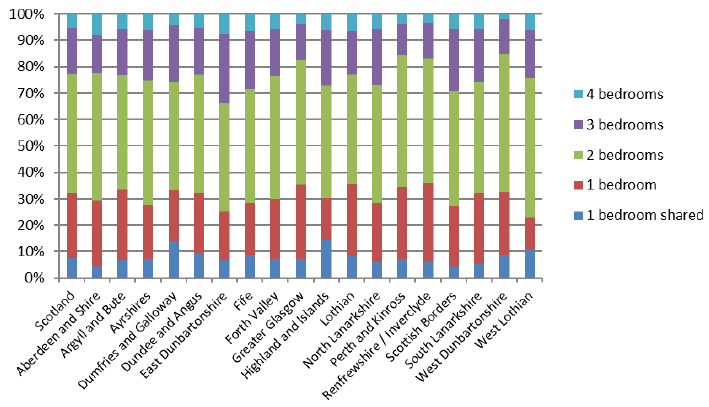
It is also important to note that there are some sample data profiles that have changed over time by property size, which may also introduce some bias into comparing overall Broad Rental Market Area averages over time.
Chart C2 shows an example of this for Argyll and Bute, for which the sample data profile has changed over time both in the total number of records and the proportion in each property size category. The proportion of records relating to 1 bedroom shared properties increased from 3% in 2010 to 16% in 2013, after which this percentage has dropped to 7% in 2018. whilst the proportion of records relating to 2 bedroom properties decreased from 43% to 34% from 2010 to 2014 but then increased back to 43% in 2018. This would add bias to the trends if an overall "average" rent figure was calculated (averaged across all property sizes) each year.
Chart C2: An Example of Sample Data Profiles that can Change Over Time - Argyll and Bute broad rental market area
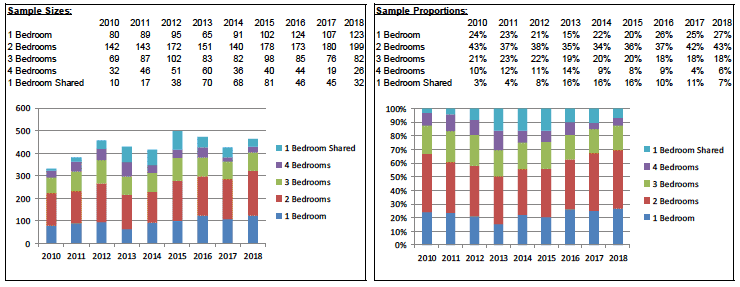
Chart C3 shows the proportions of the total samples that are within each Broad Rental Market Area each year, by property size. For most property sizes each rental area has a relatively consistent proportion each year, which gives some reassurance that averages for each property size (but not across all property sizes) can be presented at a Scotland level without bias appearing in the trend results.
Chart C3: Sample Numbers in Broad Rental Market Areas, as proportions of the Scotland total
1 bedroom properties
| 2010 | 2011 | 2012 | 2013 | 2014 | 2015 | 2016 | 2017 | 2018 | |
|---|---|---|---|---|---|---|---|---|---|
| Aberdeen and Shire | 10% | 13% | 12% | 10% | 11% | 10% | 12% | 11% | 11% |
| Argyll and Bute | 1% | 2% | 2% | 1% | 2% | 2% | 2% | 2% | 2% |
| Ayrshires | 7% | 6% | 5% | 4% | 4% | 5% | 5% | 5% | 5% |
| Dumfries and Galloway | 1% | 1% | 2% | 2% | 2% | 2% | 2% | 2% | 2% |
| Dundee and Angus | 6% | 8% | 8% | 9% | 8% | 7% | 6% | 5% | 5% |
| East Dunbartonshire | 1% | 2% | 1% | 1% | 1% | 2% | 2% | 1% | 1% |
| Fife | 4% | 3% | 4% | 5% | 3% | 5% | 5% | 5% | 5% |
| Forth Valley | 5% | 4% | 4% | 4% | 4% | 5% | 6% | 5% | 4% |
| Greater Glasgow | 16% | 14% | 17% | 18% | 21% | 19% | 20% | 20% | 21% |
| Highland and Islands | 3% | 4% | 4% | 4% | 5% | 5% | 4% | 4% | 3% |
| Lothian | 23% | 18% | 22% | 21% | 18% | 17% | 15% | 19% | 19% |
| North Lanarkshire | 3% | 3% | 3% | 2% | 3% | 3% | 3% | 3% | 3% |
| Perth and Kinross | 3% | 4% | 4% | 3% | 4% | 4% | 4% | 4% | 3% |
| Renfrewshire / Inverclyde | 6% | 7% | 4% | 5% | 4% | 5% | 6% | 5% | 6% |
| Scottish Borders | 2% | 2% | 2% | 3% | 2% | 3% | 3% | 3% | 2% |
| South Lanarkshire | 6% | 5% | 4% | 5% | 4% | 3% | 4% | 4% | 5% |
| West Dunbartonshire | 1% | 2% | 1% | 1% | 1% | 2% | 2% | 1% | 1% |
| West Lothian | 2% | 2% | 1% | 2% | 2% | 2% | 1% | 1% | 1% |
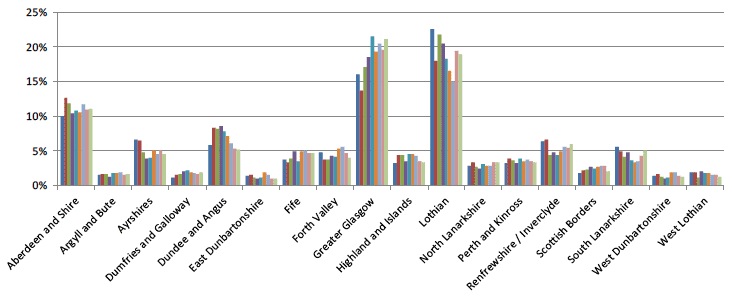
2 bedroom properties
| 2010 | 2011 | 2012 | 2013 | 2014 | 2015 | 2016 | 2017 | 2018 | |
|---|---|---|---|---|---|---|---|---|---|
| Aberdeen and Shire | 5% | 8% | 9% | 9% | 9% | 8% | 10% | 11% | 11% |
| Argyll and Bute | 1% | 1% | 2% | 1% | 1% | 1% | 1% | 1% | 1% |
| Ayrshires | 7% | 7% | 5% | 5% | 5% | 6% | 6% | 6% | 6% |
| Dumfries and Galloway | 2% | 3% | 3% | 3% | 3% | 3% | 3% | 3% | 2% |
| Dundee and Angus | 6% | 8% | 8% | 7% | 8% | 7% | 8% | 6% | 6% |
| East Dunbartonshire | 2% | 1% | 1% | 1% | 1% | 1% | 1% | 1% | 1% |
| Fife | 6% | 5% | 6% | 7% | 6% | 7% | 5% | 5% | 6% |
| Forth Valley | 6% | 5% | 5% | 5% | 5% | 6% | 6% | 4% | 4% |
| Greater Glasgow | 14% | 13% | 14% | 15% | 16% | 15% | 17% | 19% | 19% |
| Highland and Islands | 6% | 7% | 7% | 5% | 7% | 6% | 6% | 6% | 5% |
| Lothian | 18% | 14% | 15% | 16% | 14% | 15% | 14% | 16% | 15% |
| North Lanarkshire | 4% | 5% | 4% | 4% | 4% | 4% | 4% | 4% | 4% |
| Perth and Kinross | 4% | 4% | 5% | 4% | 4% | 4% | 3% | 3% | 3% |
| Renfrewshire / Inverclyde | 6% | 6% | 5% | 4% | 5% | 4% | 5% | 4% | 5% |
| Scottish Borders | 2% | 3% | 3% | 3% | 3% | 3% | 2% | 2% | 2% |
| South Lanarkshire | 6% | 6% | 5% | 5% | 4% | 4% | 4% | 4% | 4% |
| West Dunbartonshire | 2% | 1% | 1% | 2% | 1% | 2% | 2% | 2% | 2% |
| West Lothian | 4% | 3% | 2% | 3% | 3% | 3% | 3% | 3% | 3% |
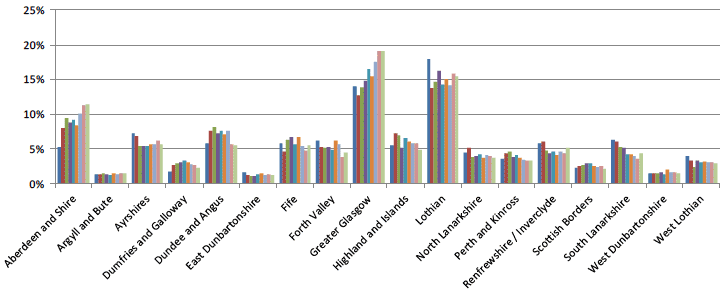
3 bedroom properties
| 2010 | 2011 | 2012 | 2013 | 2014 | 2015 | 2016 | 2017 | 2018 | |
|---|---|---|---|---|---|---|---|---|---|
| Aberdeen and Shire | 5% | 7% | 9% | 9% | 8% | 8% | 8% | 9% | 9% |
| Argyll and Bute | 1% | 2% | 2% | 2% | 2% | 2% | 2% | 2% | 2% |
| Ayrshires | 8% | 8% | 6% | 7% | 7% | 7% | 7% | 6% | 6% |
| Dumfries and Galloway | 3% | 4% | 5% | 5% | 6% | 5% | 4% | 4% | 3% |
| Dundee and Angus | 4% | 4% | 5% | 5% | 6% | 6% | 7% | 6% | 6% |
| East Dunbartonshire | 2% | 2% | 1% | 2% | 2% | 2% | 2% | 2% | 2% |
| Fife | 6% | 5% | 4% | 8% | 8% | 9% | 9% | 7% | 8% |
| Forth Valley | 6% | 5% | 4% | 4% | 4% | 5% | 6% | 5% | 5% |
| Greater Glasgow | 10% | 9% | 9% | 10% | 10% | 11% | 12% | 15% | 15% |
| Highland and Islands | 8% | 9% | 9% | 7% | 9% | 7% | 7% | 7% | 6% |
| Lothian | 19% | 14% | 15% | 14% | 12% | 14% | 12% | 13% | 16% |
| North Lanarkshire | 4% | 4% | 4% | 4% | 4% | 5% | 4% | 5% | 5% |
| Perth and Kinross | 3% | 4% | 4% | 3% | 4% | 3% | 3% | 2% | 2% |
| Renfrewshire / Inverclyde | 5% | 5% | 4% | 4% | 6% | 4% | 5% | 4% | 4% |
| Scottish Borders | 4% | 4% | 5% | 5% | 4% | 4% | 4% | 3% | 3% |
| South Lanarkshire | 6% | 7% | 6% | 5% | 4% | 4% | 4% | 5% | 5% |
| West Dunbartonshire | 1% | 2% | 1% | 2% | 2% | 2% | 1% | 1% | 1% |
| West Lothian | 4% | 4% | 3% | 4% | 3% | 3% | 3% | 3% | 3% |
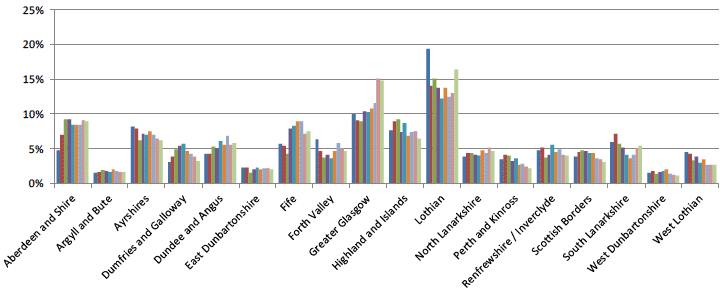
4 bedroom properties
| 2010 | 2011 | 2012 | 2013 | 2014 | 2015 | 2016 | 2017 | 2018 | |
|---|---|---|---|---|---|---|---|---|---|
| Aberdeen and Shire | 6% | 8% | 10% | 17% | 16% | 16% | 17% | 14% | 16% |
| Argyll and Bute | 2% | 2% | 2% | 3% | 2% | 2% | 3% | 1% | 2% |
| Ayrshires | 6% | 6% | 5% | 7% | 6% | 6% | 6% | 6% | 6% |
| Dumfries and Galloway | 3% | 4% | 3% | 4% | 4% | 3% | 4% | 3% | 2% |
| Dundee and Angus | 3% | 5% | 5% | 5% | 6% | 6% | 5% | 7% | 6% |
| East Dunbartonshire | 2% | 2% | 2% | 2% | 2% | 3% | 2% | 3% | 2% |
| Fife | 5% | 5% | 8% | 7% | 9% | 9% | 9% | 8% | 7% |
| Forth Valley | 6% | 6% | 5% | 4% | 4% | 5% | 6% | 5% | 5% |
| Greater Glasgow | 11% | 10% | 10% | 7% | 7% | 7% | 8% | 13% | 12% |
| Highland and Islands | 6% | 8% | 8% | 7% | 7% | 7% | 7% | 6% | 6% |
| Lothian | 23% | 18% | 19% | 14% | 13% | 13% | 12% | 11% | 19% |
| North Lanarkshire | 5% | 4% | 4% | 3% | 3% | 3% | 3% | 4% | 4% |
| Perth and Kinross | 3% | 3% | 3% | 4% | 4% | 3% | 3% | 2% | 2% |
| Renfrewshire / Inverclyde | 3% | 4% | 3% | 4% | 4% | 5% | 4% | 4% | 3% |
| Scottish Borders | 4% | 4% | 4% | 4% | 4% | 3% | 3% | 2% | 2% |
| South Lanarkshire | 7% | 5% | 7% | 5% | 4% | 3% | 4% | 6% | 5% |
| West Dunbartonshire | 1% | 1% | 1% | 1% | 1% | 1% | 1% | 1% | 0% |
| West Lothian | 4% | 3% | 3% | 3% | 3% | 3% | 3% | 3% | 3% |
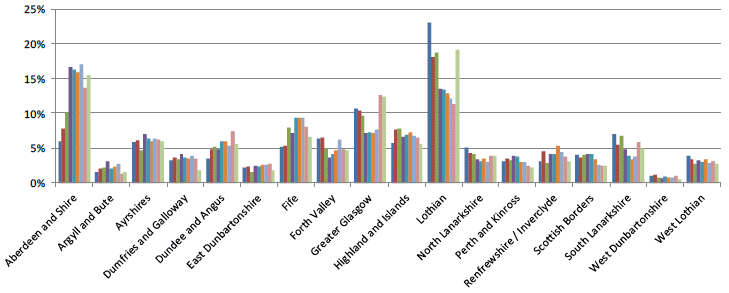
1 bedroom shared properties
| 2010 | 2011 | 2012 | 2013 | 2014 | 2015 | 2016 | 2017 | 2018 | |
|---|---|---|---|---|---|---|---|---|---|
| Aberdeen and Shire | 11% | 12% | 12% | 7% | 8% | 6% | 5% | 4% | 6% |
| Argyll and Bute | 1% | 1% | 2% | 3% | 4% | 4% | 2% | 2% | 1% |
| Ayrshires | 3% | 4% | 5% | 6% | 6% | 6% | 6% | 6% | 5% |
| Dumfries and Galloway | 4% | 4% | 3% | 3% | 4% | 4% | 4% | 4% | 5% |
| Dundee and Angus | 8% | 8% | 7% | 5% | 5% | 4% | 5% | 8% | 7% |
| East Dunbartonshire | 2% | 2% | 1% | 2% | 1% | 1% | 1% | 1% | 1% |
| Fife | 4% | 4% | 6% | 8% | 8% | 10% | 8% | 7% | 7% |
| Forth Valley | 3% | 3% | 3% | 4% | 6% | 6% | 5% | 6% | 4% |
| Greater Glasgow | 15% | 18% | 19% | 19% | 14% | 12% | 10% | 15% | 17% |
| Highland and Islands | 8% | 8% | 7% | 6% | 7% | 9% | 9% | 7% | 10% |
| Lothian | 20% | 15% | 16% | 16% | 17% | 16% | 20% | 17% | 18% |
| North Lanarkshire | 4% | 3% | 3% | 3% | 3% | 3% | 4% | 4% | 3% |
| Perth and Kinross | 4% | 3% | 4% | 3% | 3% | 2% | 3% | 3% | 3% |
| Renfrewshire / Inverclyde | 4% | 4% | 3% | 4% | 5% | 5% | 5% | 4% | 4% |
| Scottish Borders | 1% | 1% | 1% | 2% | 2% | 2% | 2% | 2% | 1% |
| South Lanarkshire | 4% | 4% | 3% | 3% | 4% | 3% | 3% | 4% | 3% |
| West Dunbartonshire | 1% | 1% | 1% | 1% | 3% | 3% | 2% | 2% | 2% |
| West Lothian | 3% | 4% | 2% | 3% | 3% | 3% | 4% | 3% | 3% |
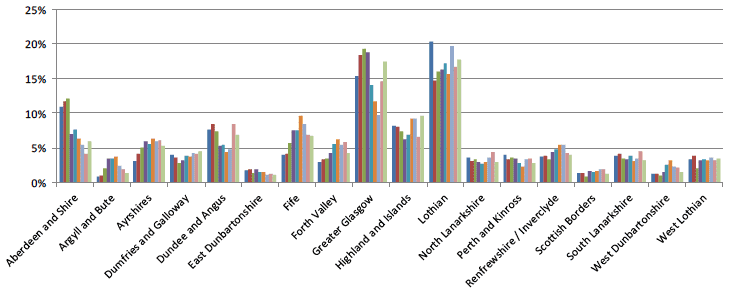
Contact
Email: Felix Palin
There is a problem
Thanks for your feedback